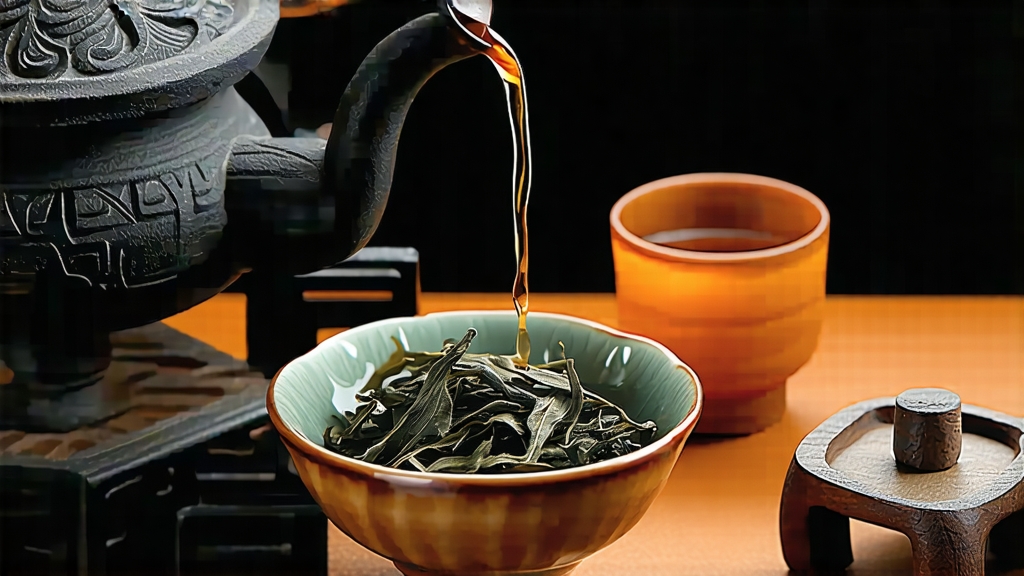
If green tea is the fresh-faced scholar of Chinese tea and pu-erh the bearded sage, then Da Hong Pao stands as the battle-scarred monarch—regal, complex, and veiled in dynastic legend. Nestled inside the 60-kilometer crescent of Fujian’s Wuyi Mountains, this oolong commands prices higher than gold by weight and inspires pilgrimages from Tokyo to Turin. Yet beyond auction headlines lies a living craft: leaves coaxed from nearly vertical cliffs, withered in mountain wind, bruised by hand, charcoal-roasted for 20 hours, then coaxed into an amber liquor that tastes of roasted peach pit, river stone, and distant orchid. Understanding Da Hong Pao is therefore a journey through geology, Ming-dynasty poetry, Qing-era taxation records, Republican-era espionage, and the 21st-century auction room. The following 2,000 words serve as your map.
-
Myth & Documented History
Local guides still repeat the 1385 legend: a Ming scholar, en route to the capital, collapsed outside the Tianxin Temple. Monks brewed leaves plucked from four bushes clinging to Jiulongke (“Nine-Dragon Hollow”) to revive him. The scholar recovered, took first place in the imperial exam, returned in crimson robes, draped his cape over the bushes to honor them—hence “Big Red Robe.” Imperial records first list “Yan Cha” (rock tea) as tribute in 1541, but the name Da Hong Pao does not appear in county gazetteers until 1840. By the 1920s Wuyi traders, eager to differentiate their product from cheaper lowland oolongs, popularized the romantic name, and in 2002 the state trademarked “Wuyi Da Hong Pao” as a geographical indication, legally tying it to 279 square kilometres within Chong’an County. -
Micro-terroir: Why “Rock Rhyme” Matters
The Wuyi range is a 100-million-year-old rift valley whose purple-red tuff has weathered into a shallow, mineral-rich soil. Day-night temperature swings of 15 °C force slow growth; morning mist refracts sunlight, increasing amino acids; and constant spring water aerosol deposits trace minerals on leaf surfaces. Locals speak of “yan yun” (rock rhyme) – a tactile finish reminiscent of wet slate that lingers in the throat. Modern ion-chromatography shows double the manganese and strontium of neighboring counties, minerals that amplify umami and create the signature textured finish. -
Garden Hierarchy: Mother Trees, Pure Clones, Blends
Only six original “mother trees” still survive on Tianxin Rock, now protected by UNESCO and fenced off since 2006 when the last commercial harvest (20 g) sold for ¥208,000. Most drinkers encounter one of three categories:
a) Beidou #1 & #2 – cuttings taken in 1964 from the mother trees, propagated in state nurseries; genetically identical, yielding 1.2 t/year collectively.
b) Qidan – a separate 1950s selection from the same cliff face, now 300 mu (20 ha).
c) Blended “Commodity DHP” – 30-50% Beidou/Qidan mixed with Wuyi Rougui, Shui Xian, or Tie Luo Han to stretch volume while maintaining rock character. Legally the GI label can still read “Da Hong Pao” as long as 60% of the blend originates within the core scenic zone. -
Craft: The Eight-Stage Cliff-to-Cup Sequence
1) Plucking – 3–4 leaves with 7 cm stems in late April when the third leaf is 50% the size of the second; stems contain soluble sugars that feed caramelization later.
2) Solar withering – spread 3 cm thick on bamboo screens at 28 °C for 20 min; triggers grassy hexenal conversion.
3) Indoor withering – moved to 22 °C cave-like rooms for 6 h; repeated tossing on water-willow racks bruises edges, initiating oxidation.
4) Shaking – the signature “green leaf with red edge” target (30% oxidation) is reached after 4–5 tosses every hour; masters listen for the rustle pitch that signals cell rupture.